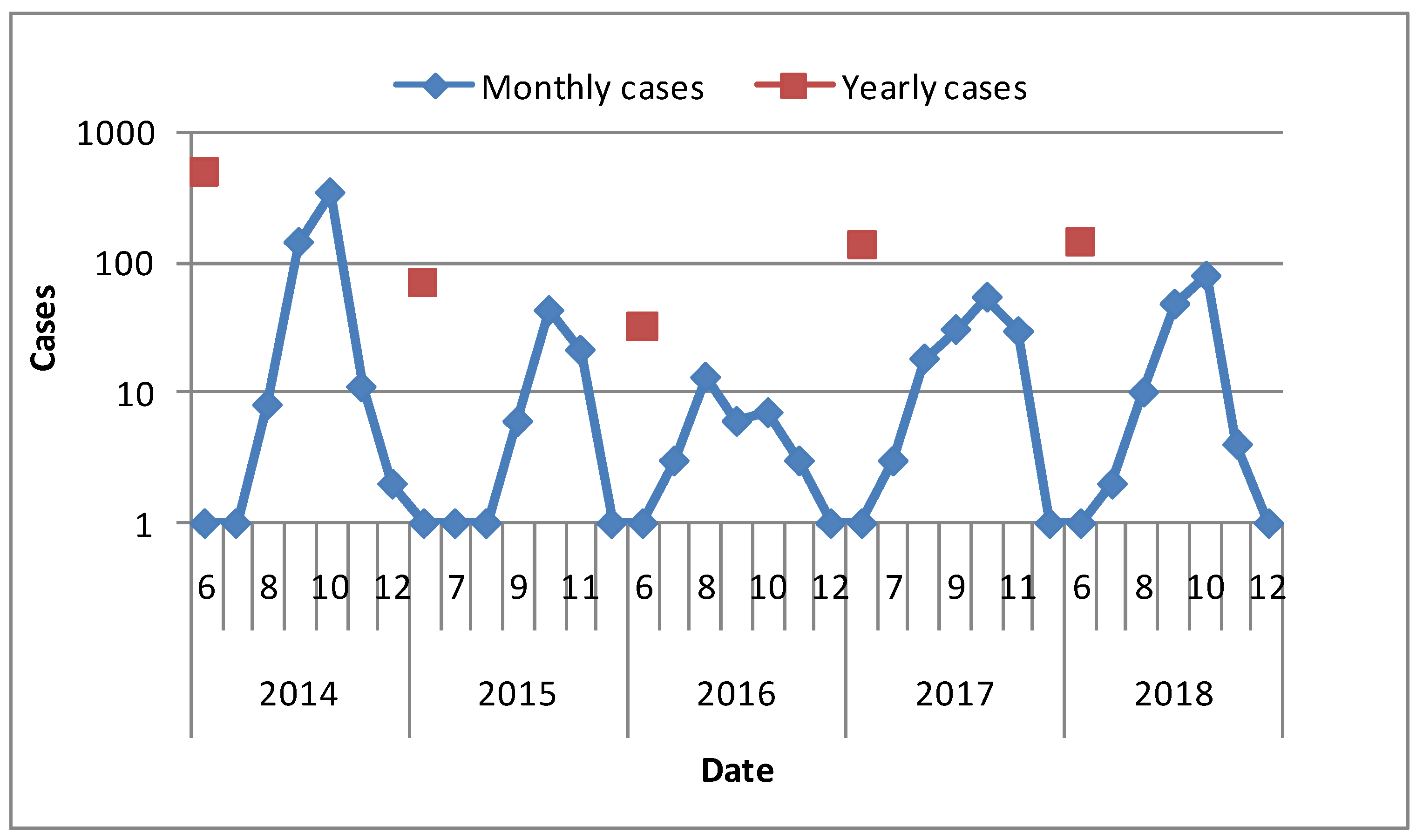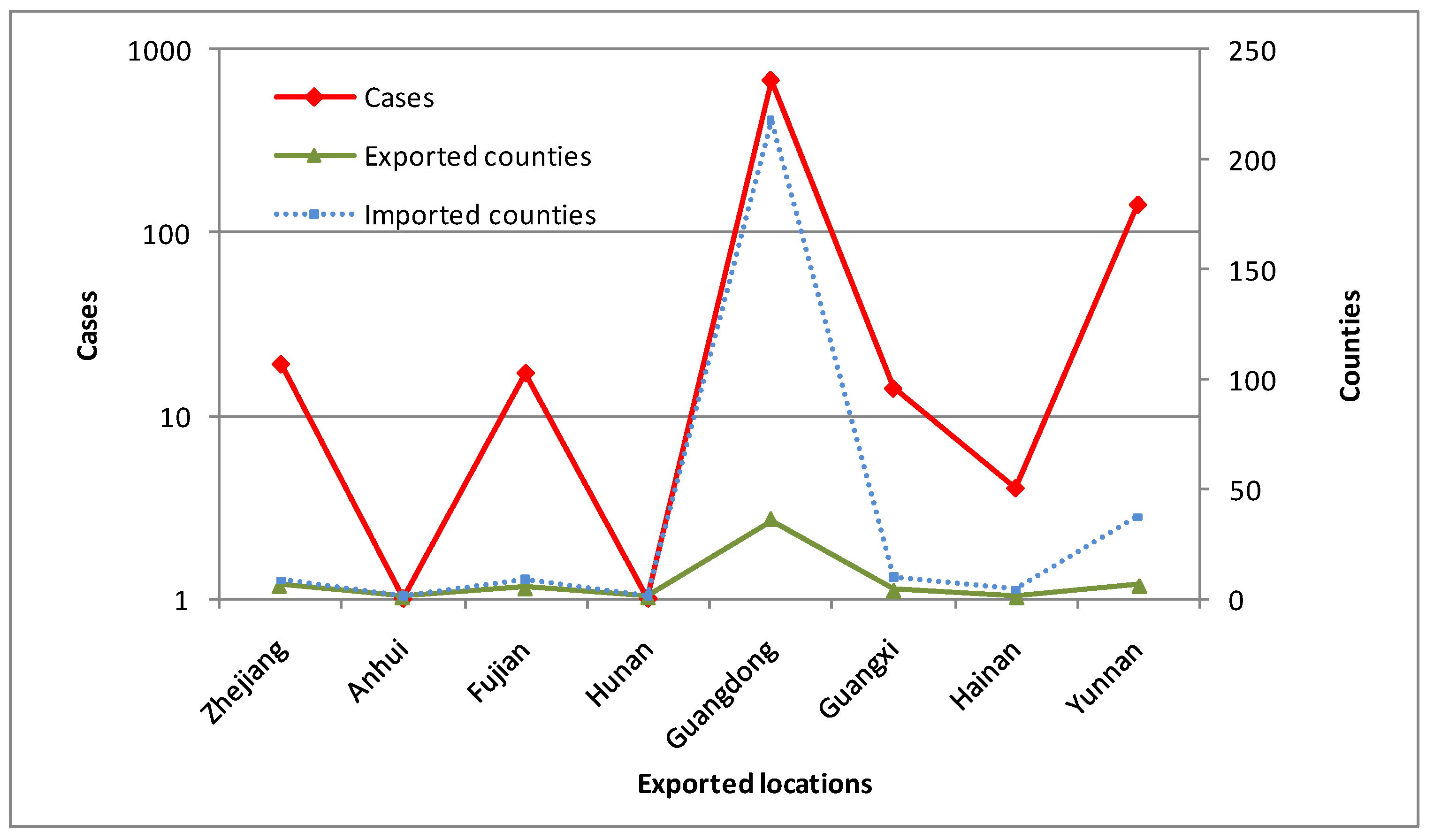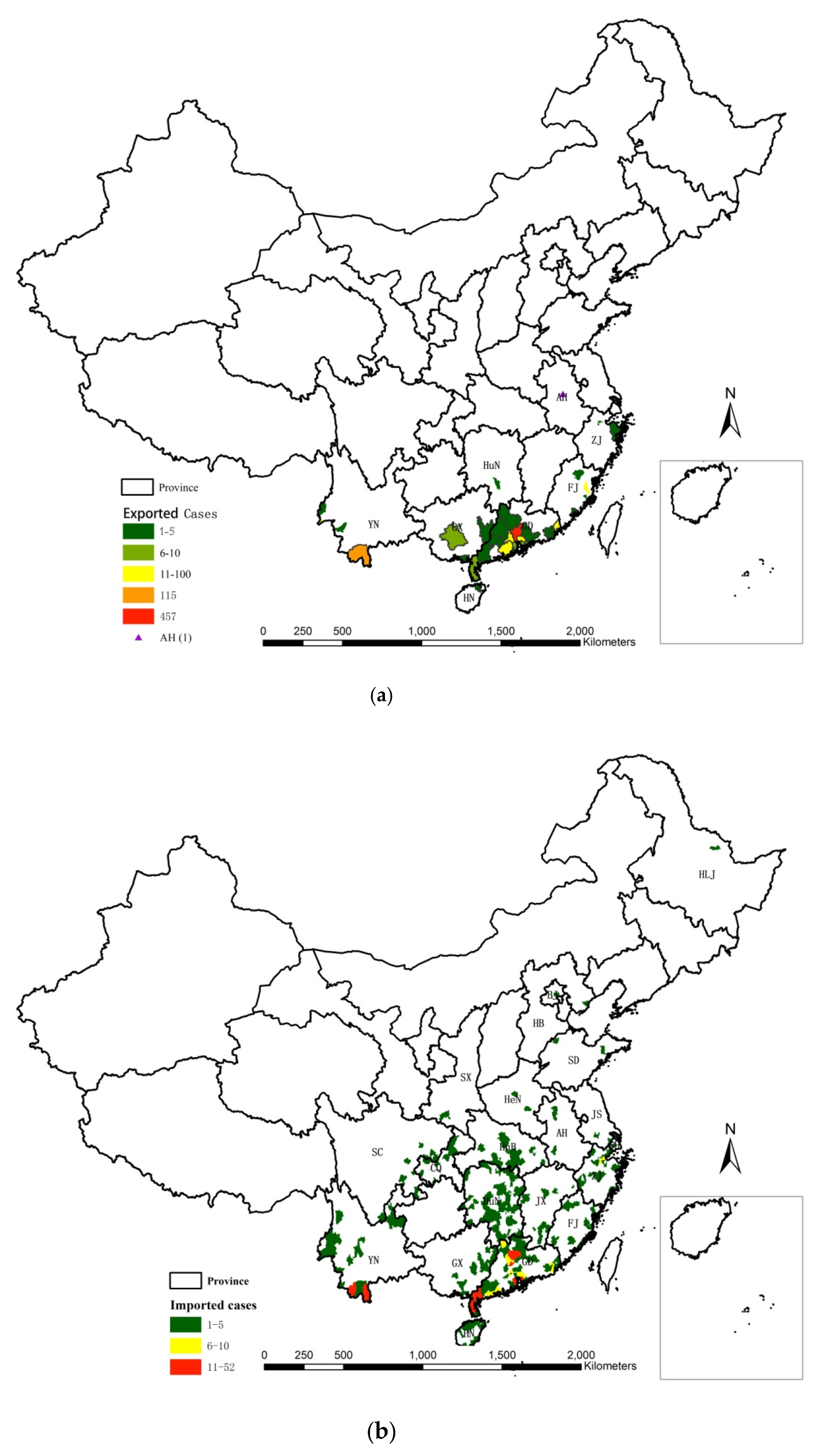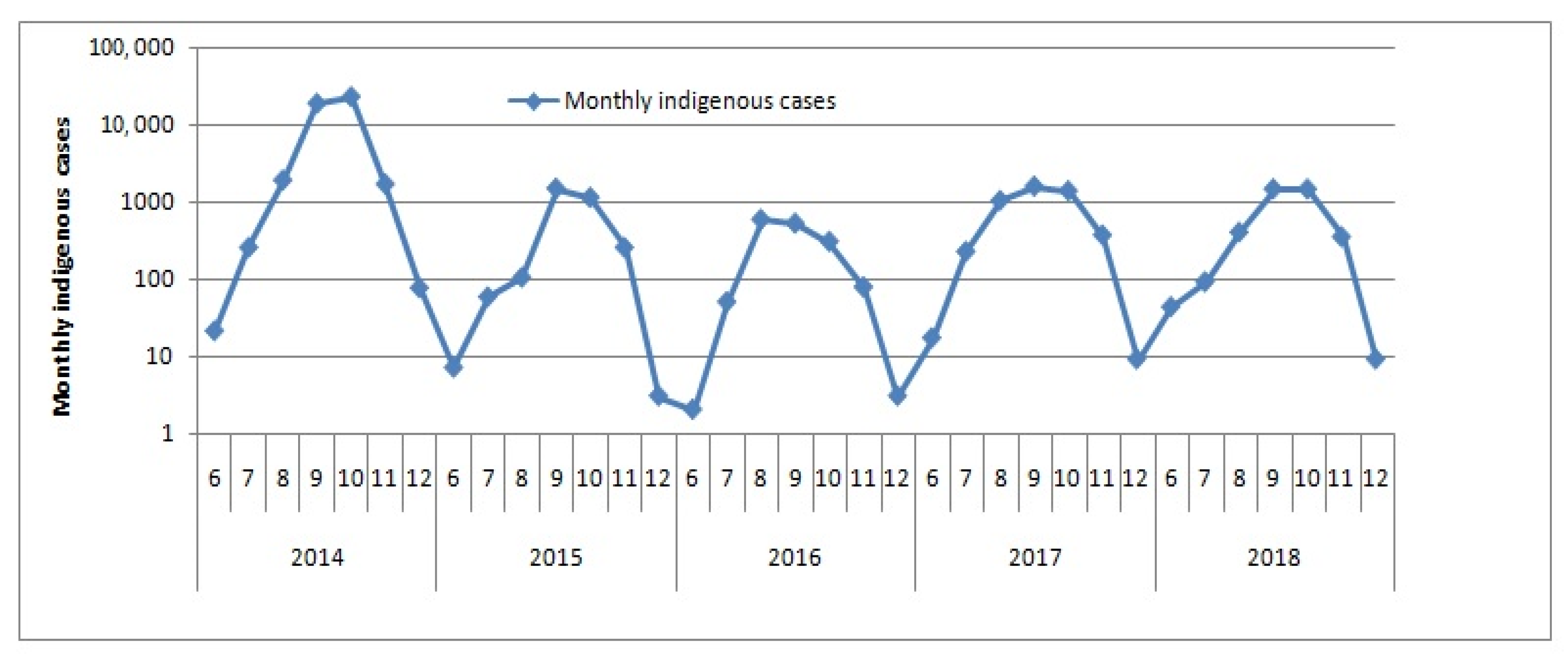Exploring Epidemiological Characteristics of Domestic Imported Dengue Fever in Mainland China, 2014–2018
Abstract
1. Introduction
2. Materials and Methods
2.1. Data Collection
2.2. Data Processing
2.3. Data Analysis
3. Results
3.1. Time-Series Analyses
3.2. Spatial Mobility Analyses
3.3. Crowd Analyses
4. Discussion
5. Conclusions
Author Contributions
Funding
Conflicts of Interest
References
- Bhatt, S.; Gething, P.W.; Brady, O.J.; Messina, J.P.; Farlow, A.W.; Moyes, C.L.; Myers, M.F. The global distribution and burden of dengue. Nature 2013, 496, 504–507. [Google Scholar] [CrossRef]
- Sang, S.; Gu, S.; Bi, P.; Yang, W.Z.; Xu, L.; Yang, J.; Chu, C. Predicting unprecedented dengue outbreak using imported cases and climatic factors in Guangzhou, 2014. PLoS Negl. Trop. Dis. 2015, 9, e0003808. [Google Scholar] [CrossRef]
- Guzman, M.G.; Harris, E. Dengue. Lancet 2015, 385, 453–465. [Google Scholar] [CrossRef]
- Chen, B.; Liu, Q.Y. Dengue fever in China. Lancet 2015, 385, 1621–1622. [Google Scholar] [CrossRef]
- Yue, Y.; Sun, J.; Liu, X.; Ren, D.; Liu, Q.; Xiao, X.; Lu, L. Spatial Analysis of Dengue Fever and Exploring Its Environmental and Socio-economic Risk Factors Using Ordinary Least Squares: A Case Study in five Districts, Guangzhou City, China, 2014. Int. J. Infect. Dis. 2018, 75, 39–48. [Google Scholar] [CrossRef] [PubMed]
- Wu, J.; Lun, Z.; James, A. Review: Dengue fever in Mainland China. Am. J. Trop. Med. Hyg. 2010, 83, 664–671. [Google Scholar] [CrossRef] [PubMed]
- Lai, S.J.; Huang, Z.J.; Zhou, H.; Anders, K.L.; Perkins, T.A.; Yin, W.; Qiu, Y. The changing epedemiology of dengue in china 1990–2014: A descriptive analysis of 25 years of nationwide surveillance data. BMC Med. 2015, 13, 100. [Google Scholar] [CrossRef]
- Castro, D.B.; Sampaio, V.S.; Albuquerque, B.C.; Pinto, R.S.; Sadahiro, M.; Passos, R.A.; Braga, J.U. Dengue epidemic typology and risk factors for extensive epidemic in Amazonas state, Brazil, 2010–2011. BMC Public Health 2018, 18, 356. [Google Scholar] [CrossRef]
- Corner, R.J.; Dewan, A.M.; Hashizume, M. Modelling typhoid risk in Dhaka Metropolitan Area of Bangladesh: The role of socio-economic and environmental factors. Int. J. Health Geogr. 2013, 12, 13. [Google Scholar] [CrossRef]
- Dewan, A.M.; Abdullah, A.Y.M.; Shogib, M.R.I.; Karim, R.; Rahman, M.M. Exploring spatial and temporal patterns of visceral leishmaniasis in endemic areas of Bangladesh. Trop. Med. Health 2017, 45, 29. [Google Scholar] [CrossRef][Green Version]
- Fan, J.; Lin, H.; Wang, C.; Bai l Yang, S.; Chu, C.; Yang, W.; Liu, Q. Identifying the high-risk areas and associated meteorological factors of dengue transmission in Guangdong Province, China from 2005 to 2011. Epidemiol Infect 2014, 142, 634–643. [Google Scholar] [CrossRef] [PubMed]
- Hashizume, M.; Dewan, A.M.; Sunahara, T.; Rahman, M.Z.; Yamamoto, T. Hydroclimato-logical variability and dengue transmission in Dhaka, Bangladesh: A time-series study. BMC Infect. Dis. 2012, 12, 98. [Google Scholar] [CrossRef] [PubMed]
- Lai, L.W. Influence of environmental conditions on asynchronous outbreaks of dengue disease and increasing vector population in Kaohsiung, Taiwan. Int. J. Environ. Health Res. 2011, 21, 133–146. [Google Scholar] [CrossRef] [PubMed]
- Lippi, C.A.; Stewart-Ibarra, A.M.; Muñoz, A.G.; Borbor-Cordova, M.J.; Mejía, R.; Rivero, K.; Ryan, S. The social and spatial ecology of dengue presence and burden during an outbreak in Guayaquil, Ecuador, 2012. Int. J. Environ. Res. Public Health 2018, 15, 827. [Google Scholar] [CrossRef]
- Liu, C.X.; Liu, Q.Y.; Lin, H.L.; Xin, B.Q.; Nie, J. Spatial analysis of dengue fever in Guangdong Province, China, 2001–2006. Asia Pac. J. Public Health 2014, 6, 58–66. [Google Scholar] [CrossRef]
- Liu, K.; Sun, J.; Liu, X.; Li, R.; Wang, Y.; Lu, L.; Liu, Q. Spatiotemporal patterns and determinants of dengue at county level in China from 2005–2017. Int. J. Infect. Dis. 2018, 77, 96–104. [Google Scholar] [CrossRef]
- Liu, Q.; Xu, W.; Lu, S.; Jiang, J.; Zhou, J.; Shao, Z.; Jin, S. Landscape of emerging and re-emerging infectious diseases in China impact of ecology, climate, and behavior. Front. Med. 2018, 12, 3–22. [Google Scholar] [CrossRef]
- Sun, J.M.; Lu, L.; Wu, H.X.; Yang, J.; Xu, L.; Sang, S.W.; Liu, Q. Epidemiological trends of dengue in mainland China, 2005–2015. Int. J. Infect. Dis. 2017, 57, 86–91. [Google Scholar] [CrossRef]
- Wang, C.G.; Jiang, B.F.; Fan, J.C.; Wang, F.R.; Liu, Q.Y. A study of the dengue outbreak and meteorological factors in Guangzhou, China, by using a Zero-Inflated Poisson Regression model. Asia Pac. J. Public Health 2013, 26, 48–57. [Google Scholar] [CrossRef]
- Wang, C.G.; Yang, W.Z.; Fan, J.C.; Wang, F.R.; Jiang, B.F.; Liu, Q.Y. Spatial and temporal patterns of dengue in Guangdong Province of China. Asia Pac. J. Public Health 2013, 27, 844–853. [Google Scholar] [CrossRef]
- Yue, Y.J.; Liu, X.B.; Xu, M.; Ren, D.S.; Liu, Q.Y. Epidemiological dynamics of dengue fever in mainland China, 2014–2018. Int. J. Infect. Dis. 2019, 86, 82–93. [Google Scholar] [CrossRef] [PubMed]
- Ministry of Health of the People’s Republic of China. Diagnostic criteria and principle of management of dengue(WS 216-2001); Standards Press of China: Beijing, China, 2001; pp. 1–12. (In Chinese)
- Ministry of Health of the People’s Republic of China. Diagnostic criteria for dengue (WS 216-2008); People’s Medical Publishing House: Beijing, China, 2008; pp. 1–17. (In Chinese)
- ESRI. ArcGIS 10.3 Help; ESRI Press: Redlands, CA, USA, 2017; Available online: http://desktop.arcgis.com/zh-cn/ (accessed on 30 June 2017).
- Ng, L.C.; Chem, Y.K.; Koo, C.; Mudin, R.N.; Amin, F.M.; Lee, K.S.; Kheong, C.C. 2013 dengue outbreaks in Singapore and Malaysia caused by different viral strains. Am. J. Trop. Med. Hyg. 2015, 92, 1150–1155. [Google Scholar] [CrossRef] [PubMed]
- Kutsuna, S.; Kato, Y.; Moi, M.L.; Kotaki, A.; Ota, M.; Shinohara, K.; Sato, T. Autochthonous dengue fever, Tokyo, Japan, 2014. Emerg. Infect. Dis. 2015, 21, 517–520. [Google Scholar] [CrossRef]
- Simmons, C.; Farrar, J.; van Vinh Chau, N.; Wills, B. Dengue. N. Engl. J. Med. 2012, 366, 1423–1432. [Google Scholar] [CrossRef] [PubMed]
- Sang, S.; Yin, W.; Bi, P.; Zhang, H.; Wang, C.; Liu, X.; Chen, B.; Yang, W.; Liu, Q. Predicting local dengue transmission in Guangzhou, China, through the Influence of imported Cases, mosquito density and climate variability. PLoS ONE 2014, 9, e102755. [Google Scholar] [CrossRef] [PubMed]





| Exported Location | Cases | Numbers of Exported Counties | Numbers of Imported Provinces | Numbers of Imported Counties |
|---|---|---|---|---|
| Zhejiang | 19 | 6 | 3 | 8 |
| Aihui | 1 | 1 | 1 | 1 |
| Fujian | 17 | 5 | 3 | 9 |
| Hunan | 1 | 1 | 1 | 1 |
| Guangdong | 675 | 36 | 18 | 218 |
| Guangxi | 14 | 4 | 3 | 10 |
| Hainan | 4 | 1 | 3 | 4 |
| Yunnan | 141 | 6 | 13 | 37 |
| Year | Male Cases | Female Cases |
|---|---|---|
| 2014 | 317 | 176 |
| 2015 | 41 | 29 |
| 2016 | 10 | 22 |
| 2017 | 79 | 56 |
| 2018 | 75 | 67 |
| Age Group | Cases in 2014 | Cases in 2015 | Cases in 2016 | Cases in 2017 | Cases in 2018 |
|---|---|---|---|---|---|
| 0–10 | 8 | 0 | 1 | 2 | 2 |
| 11–20 | 65 | 11 | 3 | 19 | 17 |
| 21–30 | 164 | 15 | 6 | 39 | 46 |
| 31–40 | 114 | 16 | 1 | 34 | 31 |
| 41–50 | 85 | 15 | 9 | 24 | 26 |
| 51–60 | 38 | 11 | 6 | 13 | 15 |
| 61–70 | 13 | 2 | 5 | 3 | 4 |
| 71+ | 6 | 0 | 1 | 1 | 1 |
| Career | Cases in 2014 | Cases in 2015 | Cases in 2016 | Cases in 2017 | Cases in 2018 |
|---|---|---|---|---|---|
| Cadre | 16 | 5 | 2 | 12 | 7 |
| Worker | 64 | 7 | 5 | 20 | 21 |
| Housework or unemployed | 79 | 4 | 5 | 12 | 17 |
| Retiree | 7 | 4 | 1 | 5 | 4 |
| Migrant laborer | 37 | 6 | 0 | 5 | 4 |
| Farmer | 115 | 19 | 8 | 32 | 39 |
| Businessman | 47 | 9 | 1 | 21 | 18 |
| Student | 56 | 7 | 3 | 9 | 10 |
| Medical staff | 3 | 2 | 2 | 4 | 2 |
| Else | 24 | 3 | 0 | 5 | 7 |
| Unavailable | 45 | 4 | 5 | 10 | 13 |
© 2019 by the authors. Licensee MDPI, Basel, Switzerland. This article is an open access article distributed under the terms and conditions of the Creative Commons Attribution (CC BY) license (http://creativecommons.org/licenses/by/4.0/).
Share and Cite
Yue, Y.; Liu, Q. Exploring Epidemiological Characteristics of Domestic Imported Dengue Fever in Mainland China, 2014–2018. Int. J. Environ. Res. Public Health 2019, 16, 3901. https://doi.org/10.3390/ijerph16203901
Yue Y, Liu Q. Exploring Epidemiological Characteristics of Domestic Imported Dengue Fever in Mainland China, 2014–2018. International Journal of Environmental Research and Public Health. 2019; 16(20):3901. https://doi.org/10.3390/ijerph16203901
Chicago/Turabian StyleYue, Yujuan, and Qiyong Liu. 2019. "Exploring Epidemiological Characteristics of Domestic Imported Dengue Fever in Mainland China, 2014–2018" International Journal of Environmental Research and Public Health 16, no. 20: 3901. https://doi.org/10.3390/ijerph16203901
APA StyleYue, Y., & Liu, Q. (2019). Exploring Epidemiological Characteristics of Domestic Imported Dengue Fever in Mainland China, 2014–2018. International Journal of Environmental Research and Public Health, 16(20), 3901. https://doi.org/10.3390/ijerph16203901




